House of Westmore
On April 13, 1935, the four oldest of the six Westmore brothers – Perc, Monte, Wally and Ern – opened a luxury beauty salon at 6638 Sunset Boulevard, Hollywood. Their sister, Dorothy Westmore [1907-1931], who was also a trained make-up artist, and only one year younger than Wally, had tragically died in childbirth in 1931.
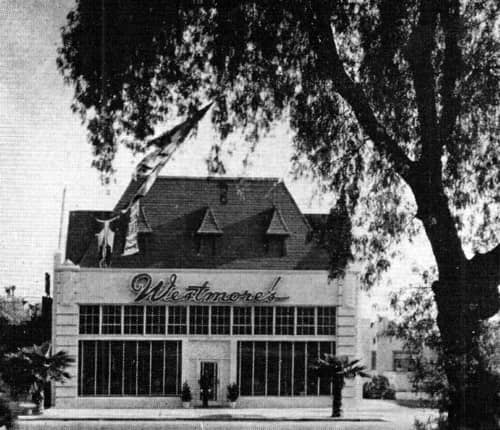
Above: 1935 The House of Westmore Salon of Beauty, designed by Harry B. Aarens [1894-1951]. The ground floor contained booths for hair cutting and styling (men, women and children), beauty treatments, make-up compartments and special rooms for electrolysis and pedicures. On the upper floor were the offices of the Westmore brothers and the wig department.
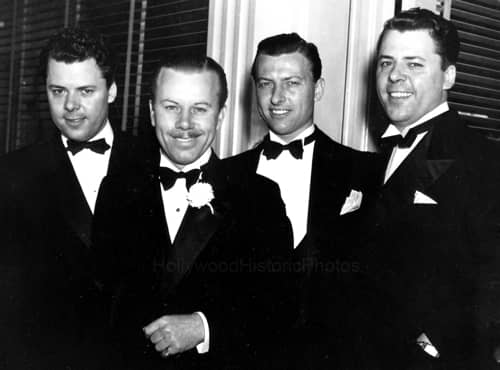
Above: 1935 The Westmore brothers at the opening of the Westmore Salon of Beauty. Left to right: Perc (Percival) Westmore [1904-1970], Monte (Montague) Westmore [1902-1940], Wally (Walter) Westmore [1906-1973} and Ern (Ernest) Westmore [1904-1968]. It would appear that Perc was the driving force behind the development of the salon and its associated cosmetic line.
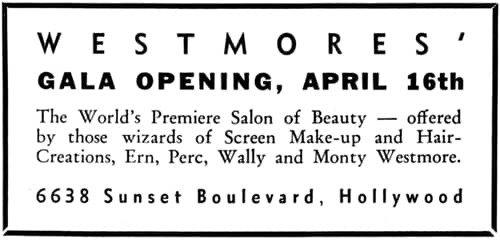
Above: 1935 Gala opening of Westmores.
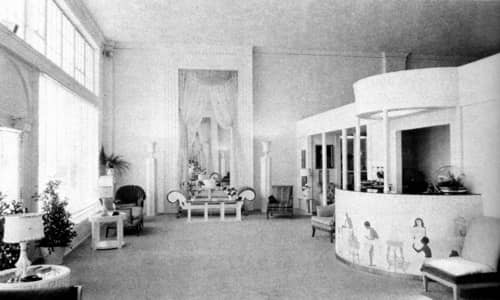
Above: 1935 Reception room in the Salon of Beauty with eggshell-shaded carpet and matching leather furniture, huge mirrors and ivory-coloured crystal bead drapes. Behind circular reception desk painted with a mural representing ancient beauty rituals was a picture of the family patriarch, George Westmore.
Opening the salon meant that Perc and Ern had to cut their close ties with the Max Factor company. I do not know where Ern learnt to be a wigmaker but Perc had apparently trained with Cervi Cesar, a major competitor of Max Factor.
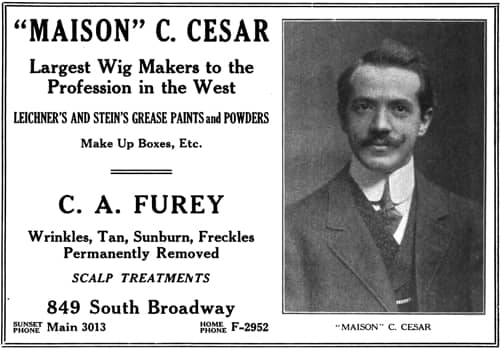
Above: 1915 Maison C. Cesar., wigmaker and make-up supplier.
Both brothers had been working in the Max Factor wig department concurrently with running make-up departments in film studios – Perc at Warner Brothers, Ern at RKO Radio Pictures. Before he left, Perc assigned a toupee patent he had developed to Max Factor (US Patent No: 1845380, 1932).
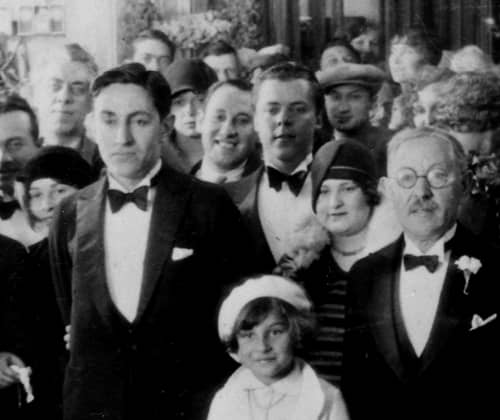
Above: 1928 Part of a photograph taken at the opening of Max Factor’s Make-up Studio on North Highland Avenue. Davis Factor [1902-1991] and Max Factor [1872-1938] can be seen in the foreground. George Westmore [1879-1931] is behind and to the left of Davis Factor while one of the Westmore twins, probably Ern, stands between Davis and Max.
In 1932, Ern resigned from RKO to join Max Factor but left in 1935 when the House of Westmore was established. Two Max Factor employees defected to Westmores with him: Leonard Dean Smith, who was put in charge of the House of Westmore advertising and publicity; and Ismael R. Alvarez, who was made Westmore’s general sales manager (The American Perfumer, 1935). Alvarez had previously worked to establish Max Factor’s export business.
See also: Max Factor
Type-Harmonized Cosmetics
Two days before the salon opened, the brothers registered The House of Westmore, Inc. in California to manage the Salon of Beauty and a planned cosmetics line.
Information on this first Westmore line of cosmetics is very sparse. It was manufactured, at least in part, at a plant at 1455 North Gordon St., Hollywood but the date for its introduction is an open question. It may have been as early as late 1935 or as late as early 1937.
Cosmetics in the line were packaged in gold, black and jade-coloured containers stamped with a Westmore coat of arms. Perc had spent US$5000 to have a genealogist trace the Westmore coat of arms back to eighteen-century England. The coat of arms, along with the lineage, proved to be bogus but it remained on the packaging.
Make-up in the range was ‘Type-Harmonized’ which meant that its shades were keyed to a woman’s overall complexion – Blonde, Brunette or Redhead. A gold, foil-covered ‘Gold Book’ was available for each type. Each contained a ‘Type-Harmonized’ chart listing the Westmore make-up shades best suited for its complexion type. The three booklets also included information on how women could maximise their attractiveness by applying make-up according to their face type – Oval, Round, Square, Oblong, Triangle, Inverted Triangle or Diamond – a system of face shapes developed by Perc and Ern Westmore earlier in the decade.
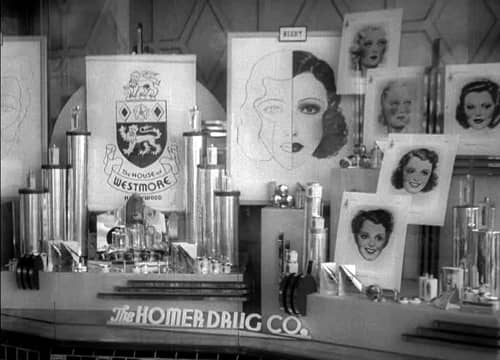
Above: 1937 Westmore cosmetics on display at a Homer Drug Company store. Note the images of different face types developed by Ern and Perc Westmore.
See also: Face Shapes
‘Magic Mirrors’ invented by Perc were installed in some Westmore outlets to help women determine their face shape.
In addition to being used exclusively in The House of Westmore the products were sold only in the fifty most soigné stores in the United States. For each store, Perc designed a unique mirror which was surrounded with lights. When you flipped on the lights and observed your reflection, fine lines would appear on the mirror to help you decide which of the seven basic face shapes you possessed.
(Westmore & Davidson, 1976, p. 110)
Unfortunately, all trace of these mirrors has been lost.
Difficulties
In July, 1937, Ern Westmore, then the company president, announced that the firm had made a modest profit of US$7447.23. However, by the following year the firm was experiencing severe financial problems bought on by bad management, undercapitalisation and profligate spending. It is also possible that the market for the cosmetics was wrong, that movie glamour only had good sales sales appeal at the lower end of the cosmetic market.
In 1938, to alleviate their financial difficulties, the brothers sold the Westmore wig department to Max Factor for US$100,000 and signed a 30-year license agreement that transferred the manufacturer, distribution and sale of Westmore cosmetics to a new House of Westmore company established in New York. This meant that there were now two House of Westmore corporations, one in New York which produced and distributed the House of Westmore cosmetics and the original company in California which received royalties from the New York firm and ran the Salon of Beauty.
There was some executive overlap between the Californian and New York firms. S. Willard Isaacs (the owner of a chain of beauty salons in Southern California) and Harry Brand (a public relations manager at 20th Century Fox) were major investors in the New York House of Westmore but also held positions in the Californian company and Perc was made president of the New York firm.
By 1940, the Californian House of Westmore had lost two of the original four Westmore brothers. In 1938, alcoholism, a second divorce and a suicide attempt, saw Ern Westmore sell his shares in the business to Max Factor before departing for London in 1939. Then, in 1940, Monte Westmore died from a heart attack following a tonsillectomy. After Ern left, George Hamilton (Bud) Westmore [1918-1973], a younger brother, joined the Californian firm. By 1944, he was listed as a company vice-president along with his brother Wally.
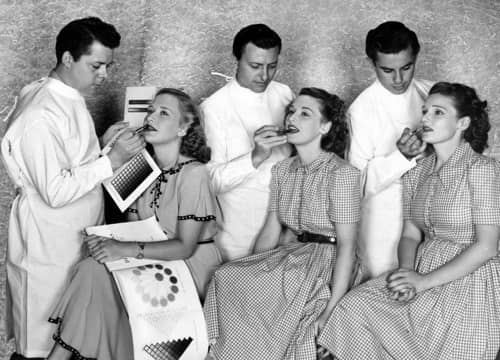
Above: Perc, Wally and Bud making up three of the Lane sisters: Priscilla [1915-1995], Rosemary [1913-1974], and Lola [1906-1981].
Distribution
As far as I can tell Westmore cosmetics were largely restricted to the United States and Canada. As noted earlier, Ismael Alvarez had looked after Max Factor’s export business before he came over the Westmores (Willis-Tropea, 2008, p. 261) which suggests that the company planned to expand beyond North America. In 1937, The House of Westmore (England) Ltd. was established at Empire House, 68 Finsbury Pavement, London and some products were sent overseas in 1938 but, if the business was still functioning, the outbreak of war in 1939 brought its activities to an end.
In 1939, Westmore (Hollywood) Ltd. was also founded in London but this was probably a separate business established by Ern Westmore and not connected with either the Californian or New York firms. The outbreak of the Second World War caused Ern to return to the United States bringing this operation to an end as well. Ern had not taken out American citizenship so was liable to be drafted if he remained in England.
Color-Filtered Cosmetics
The New York company went for volume rather than markup and priced and packaged its Westmore cosmetics for sale in variety and chain stores. The new line was boxed in green and gold containers with the Westmore crest, so had some similarity with the earlier higher-priced line, but were marked at two low price points – 25¢ and 50¢. The initial seven products in the new line – Cleansing Cream, Foundation Cream, Powder, Dry Rouge, Cream Rouge, Eyeshadow and Lipstick – were released in 1938. Mascara was added in 1940 – in Black and Brown shades – and, by 1942, Freshener and Dry Skin Cream had been introduced giving the range a rudimentary skin-care regime.
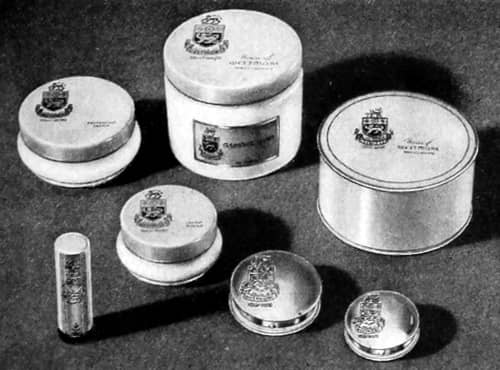
Above: 1939 House of Westmore cosmetics.
In 1942, shade ranges were as follows:
Foundation Cream: Natural, Continental, Castilian, Copper, Coral, and Rose Glow.
Face Powder: Natural, Continental, Castilian, Copper, Rose Ocre, Coral Rachelle, Westmore Tan, and Rust Brown.
Rouge: Debutante, Pepper Red, Glorious Red, Charel, and Garnet.
Lipstick: Debutante, Pepper Red, Strawberry Blond, Glorious Red, Charel, and Garnet.
Eye Shadow: Blue Gray, and Brown.
Mascara and Eyebrow Pencil: Black, and Brown.
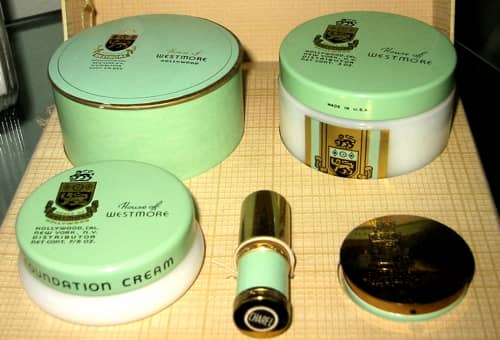
Above: Later examples of Westmore cosmetics with the New York firm clearly marked on the label.
In October, 1938, the company began an extensive advertising campaign with the make-up advertised as ‘Color-Filtered’. This idea, developed by Perc Westmore, suggested that Westmore cosmetics did not have any of the ‘harsh tones’ or ‘ageing gray shades’ found in other make-up ranges.
What Perc Westmore does for the stars, he can do for you—through his revolutionary discovery COLOR-FILTERED COSMETICS. Cosmetics free of those hidden tones that cast ugly aging shadows. Make-up that gives you a thrilling constant glow—even under unflattering lights!
(Westmore advertisement, 1939)
The claim provoked a cease and desist order from the Federal Trade Commission (FTC) under the provisions of the new 1938 Food, Drugs and Cosmetic Act (FD&CA). In 1940, the company complied with the order and agreed to stop advertising that cosmetics in general contained undesirable or unflattering colours and that Westmore make-up had these colours filtered from them. This marked the end for ‘Color-Filtered’ cosmetics.
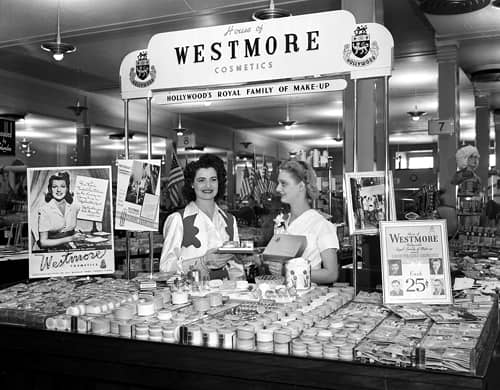
Above: 1941 Westmore counter in F. W. Woolworths.
After 1940, the company fell back on its close ties to Hollywood to sell its cosmetics, using endorsements from movie stars and Perc’s, Wally’s and Bud’s connections with major Hollywood studios – Perc at Warner Brothers, Wally at Paramount and Bud at Eagle Lion, 20th Century Fox or Universal. Unfortunately, the Westmore access to endorsements from actresses was limited as most had already been contracted by their studios to Max Factor.
Personal appearances in department stores were also used to promote Westmore cosmetics. The way this was done developed over time. Initially, the Westmores tried making personal appearances demonstrating make-up techniques. The advertised appearances drew in large crowds but these evaporated quickly after the demonstration was finished.
A new technique was developed which put customers on an ‘assembly line’, aptly demonstrated by Bud Westmore. Customers coming to a store to see Bud Westmore filed past him and received a chart appropriate for their face shape on which he marked their complexion, eye and hair colour.
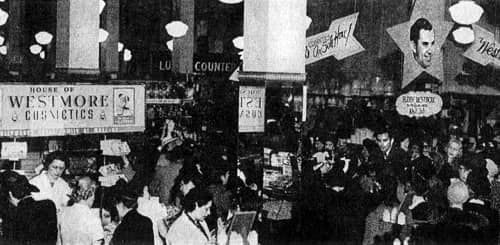
Above: 1942 Bud Westmore conducting a Westmore promotion using the ‘assembly line’ technique. He could hand out up filled in charts to 1200 women every hour. His assistant at the time, marking in the colours, was Dr. Helen Cowan.
The woman would then pass onto an assistant who would mark the correct Westmore Foundation Cream, Face Powder, Rouge, Lipstick and Eyeshadow for their colouring as indicated by Bud. A sales girl would then pick them up and attempt to make a sale.
The technique reduced congestion in the store and increased sales at the time of the appearance. It also generated good ‘come backs’ with women returning to the store with chart in hand to purchase more Westmore cosmetics (‘Putting the customer on the “assembly line”,’ 1942).
Wartime
The Westmore brother’s contributions to the American war effort were mixed. Ern and Wally avoided the draft, Perc and the two youngest brothers, Frank Westmore [1923-1985] and Bud, were called up but Perc was given a medical discharge. Perc, Ern and Wally staged make-up shows at the United Service Organizations’ Hollywood Canteen (USO) and the brothers also provided make-up advice for service personnel disfigured by facial injuries.
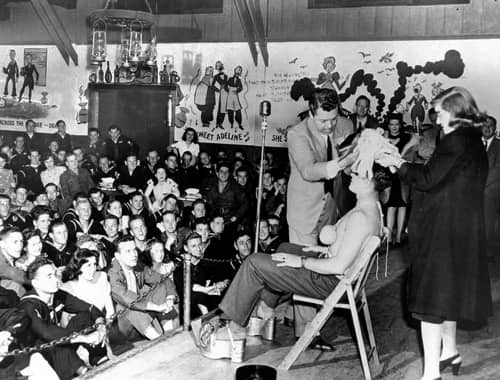
Above: 1943 Perc Westmore and Bette Davis [1908-1989] dress and makeup a soldier as a woman in the Hollywood Canteen.
The House of Westmore Salon of Beauty’s contribution to the war effort included free beauty treatments for the Women’s Army Auxiliary Corps (WAACs) and the Women Accepted for Volunteer Emergency Service (WAVES) as well as the United States Coast Guard Women’s Reserve (SPARs) (Westmore & Davidson, 1976, p. 136).
On the cosmetics front there were some developments. In 1942, the company introduced Overglo, a semi-liquid foundation in six shades, increased to seven by 1944.
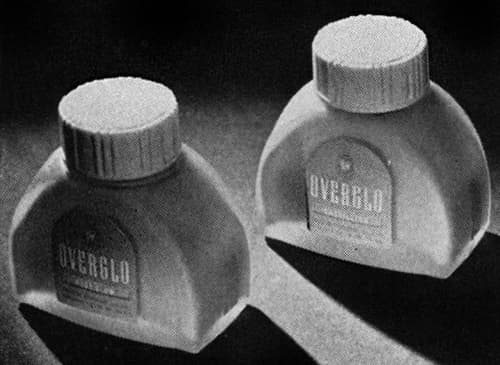
Above: 1943 Overglo.
Overglo Liquid Cream Foundation: “A long-lasting make-up that needs no powdering, no retouching! The rich lanolin oil base keeps skin soft, glowing. Doesn’t ‘cake’ or dry the skin, yet helps hide tiny blemishes and wrinkles. Just smooth on with fingers.” Shades: Natural, Coral, Castilian, Continental, Rose Glow, and Copper.
Overglo Face Powder was added in 1944. Described as non-chromatic (non-colouring), it came in one almost colourless tone that could be used over any shade of foundation, making it the first commercial face powder of its type.
Overglo Face Powder: “[M]ade in only one practically colorless shade which is suitable for every Foundation-Tinted Complexion. Permits your foundation-tinted skin to glow through with natural youthful beauty. A powder specially created for use with Overglo or any tinted cake, cream or liquid foundation.”
See also: Loose Face Powders
In 1948, Westmores introduced a third Overglo cosmetic, Overglo Creme-Cake in seven shades, which I assume were the same as the Overglo Liquid Cream. It was recommended for Normal or Oily skin types with the older Overglo Liquid Cream Foundation now suggested for women whose skin was classified as Dry.
Overglo Creme-Cake: “Treat your face to this creamy smooth make-up for complexion beauty without that ‘masked’ look. Conceals tiny lines and blemishes. Apply … with fingertips to create a flawless natural beauty.
Post-war
Information on the Westmore cosmetic range after 1945 is patchy at best. It remained focused on make-up with the only skin-care lines that I know of being Cold Cream Cleanser, Skin Freshener, and Orange Blossom Night Cream.
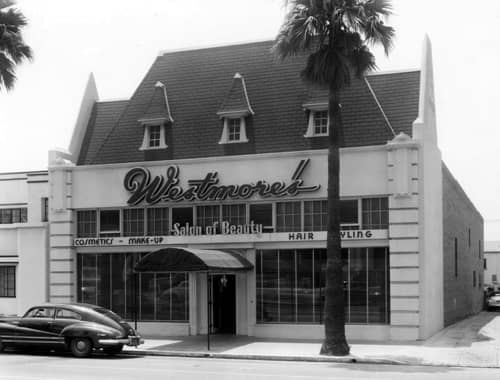
Above: House of Westmore Salon of Beauty in later years. The business was closed in 1965 but the building still stands today.
Lipsticks
Lipsticks had become more important during the war and, along with Overglo, the company spent a good deal of its immediate post-war advertising budget on them. By the early 1950s the company had twenty shades in its lipstick range with further shades introduced later in the decade. Lipstick shades developed after the war included: Danger Signal (1946), Irish Rose (1948), Rapture Pink (1949), Deb (1950), Subtle Red (1950), Subtle Pink (1950), True Red (1953), Lovely Pink (1953), Reddest Red (1955), Go Go Pink (1955), Going Steady (1955), and Pink-Orange (1957).
Westmores made some attempt to colour coordinate its lipsticks, rouges and face powders but the company does not appear to have had a nail polish in its range until the 1960s and this must have had a limiting effect on sales.
The introduction of Hazel Bishop’s Lasting Lipstick kicked off a renewed interest in indelible lipsticks in the United States in the 1950s. Hazel Bishop lipsticks were sold through the same chain and variety stores as Westmores and were in direct competition with Westmore lines. In response, Westmores began referring to its lipsticks first as ‘Non-Smear’, and then later as ‘Kiss-Tested’, both ideas used by other lipstick makers during the 1950s.
See also: Hazel Bishop
Pencil lipsticks such as Revlon’s Lip-Fashion (1948) made an appearance after the war and, in 1951, Westmores introduced its own version, French Formula Pencil Lipstick in True Pink, Light Red, Red Red, and Orange Red shades. As with other pencil lipsticks from this period they had a limited run.
See also: Lipsticks
Foundations and powders
Westmore Foundation Cream (1938), Overglo Liquid Cream Foundation (1942) and Overglo Face Powder (1944) had been good sellers and the company added a number of new foundations and powders through the 1950s. Notably absent after 1950 is any mention of products branded as Overglo. The name may have been dropped because of its similarity with Frances Denney’s Over-Tone, the two companies going to court over the matter in 1945.
New foundations and powders listed during the 1950s included: Cake Make-up, a product similar to Max Factor’s Pan-Cake that was also applied with a sponge; Cream Make-up, a pressed powder cream; Tru-Glo Liquid Make-up and Tru-Glo Face Powder, replacements for the earlier Overglo forms; Party Puff, another pressed powder cream; and Perfect Touch, another transparent finishing powder.
See also: Pan-Cake Make-up
The 1950s was the decade of ‘miracle’ ingredients. Westmores followed this trend adding royal jelly to Tru-Glo Liquid Make-up and some lipsticks for a while, and a proprietary ingredient ‘Ever-Tex’ in their Party Puff.
Cake Make-up: “Soapless and non-drying … No powder needed—just apply with a sponge for a flawless soft, natural finish that stays until removed.”
Cream Make-up: “[M]akes your skin look soft and radiantly alluring . . . blemish-Free! Just smooth on with fingertips. Powder clings all day long!”
Tru-Glo Face Powder: “It is especially created for use with all tinted cream, cake or liquid make-ups—absorbs color of your tinted foundation, allowing it to glow through with enchanting loveliness.”
Tru-Glo Liquid Make-up: “The perfect foundation for all types of skin. Gives a long-lasting, soft, protective mat finish. Easy to apply.”
Party Puff: “Creamy powder make-up containing miracle ingredient ‘Ever-Tex.’ Feather light. Puffs on in seconds. Gives that smooth, natural ‘party-fresh’ look every minute of the day.”
See also: Royal Jelly
Concealer
After Harriet Hubbard Ayer’s Ayer Magic (1952) created an interest in concealers, Westmores introduced Beauty Stick, a stick concealer, in 1954, the same year Max Factor produced its version called Erace.
Beauty Stick: “Covers dark circles, blemishes with, just a touch. Invisible on skin. Use it like a lipstick, carry it in your purse.” Shades: Light, Medium, and Dark.
See also: Corrective Make-up (Concealers)
Difficulties
The 1950s would see a number of developments that affected how Westmore marketed its products. In the longer term these changes weakened the cosmetic line and caused the New York company to reevaluate its business.
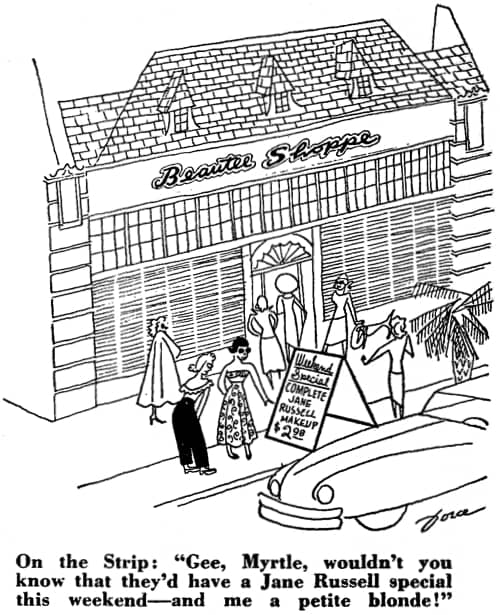
Above: 1951 As this cartoon suggests, the Westmore salon may now have been relying on tourists for much of its business.
In 1950, Perc Westmore submitted a letter of resignation to Warner Brothers. He had done this many times before but this time it was accepted. He did not find employment with any other Hollywood studio and this cost the company a valuable marketing tool. He lost the ability to be seen making up Hollywood movie stars and references to him after this date fall back on calling him ‘The Dean of Make-up’. Perhaps because of this, Frank Westmore [1923-1985], the youngest of the Westmore brothers, then working at Paramount, began to appear in company advertising.
The company’s strategy of using the Westmore brothers’ close ties to Hollywood to sell its cosmetics was further weakened by the breakup of the Hollywood studio system. This ended cheap endorsements from movie stars for Westmore cosmetics – a problem that also affected Max Factor – and was one of the reasons why all references to Hollywood in Westmore advertising ended by 1960.
See also: Max Factor (1945-1960)
A third factor that affected the company was the rise of television. This further diminished the power and prestige of the Hollywood film studios on which a lot of Westmore advertising depended. As companies like Revlon and Hazel Bishop demonstrated, television could be an extremely effective marketing platform for cosmetics but was very expensive. Westmore’s low margins and limited product range meant that its television advertising budget could only stretch to the occasional trial spot and the New York company never effectively engaged with the new medium.
See also: Lipstick Wars
Diversification
In 1957, the New York company decided to diversify its range and bought a 45% interest in The Kurlash Co., Inc., the makers of eyelash curlers and tweezers, completing its purchase of Kurlash in a stock-swap deal in 1961. By then, the company had also bought Orlin Laboratories, Inc., a private label firm that had been making cosmetics for Westmores and other cosmetic companies since 1944. The following year, Westmores bought Diamon-Deb, Inc., makers of manicure equipment including nail files, which they merged with Kurlash. The management at Westmores must have had a change of mind about these purchases as they sold the combined company to Harold M. Mitchell, Inc. in 1964.
See also: Kurlash
Other changes
By 1960, most of the shares in the New York Westmores were in the hands of the Finkelstein family who had connections with Glemby Inc., a company that operated a chain of beauty salons in hotels and department stores across the United States and elsewhere.
Westmores continued to operate through the 1960s and built new manufacturing facilities in Newburg, New York State in 1969. The lease agreement with the Californian company had expired by then and the Hollywood Salon of Beauty was no more; the Westmore brothers having shut it down in 1965. I have been unable to determine what the arrangements between the Californian and New York companies were after 1968 but it is worth noting that, in the 1960s, the New York company simply referred to itself as Westmore and all mentions of the brothers were dropped.
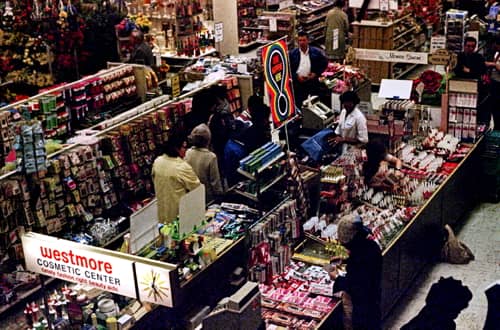
Above: 1973 A Westmore Cosmetic Center competing with other budget cosmetics in a Woolworths store in Boston.
Westmore cosmetics were still around in the 1970s but references to them seem to have disappeared after the company was sold to Syntex in 1978.
Timeline
| 1935 | House of Westmore, Inc. established in California. Westmore Salon of Beauty opens in Hollywood. |
| 1936 | 25,000 additional shares offered for the House of Westmore. |
| n.d. | House of Westmore (Hollywood) begins selling cosmetics. |
| 1937 | House of Westmore, Inc. (Hollywood) trade marked. House of Westmore (England) Ltd. founded at Empire House, 68 Finsbury Pavement, London. |
| 1938 | House of Westmore, Inc. (New York) established at 730 Fifth Ave., New York. Wig department sold to Max Factor. New Products: Cleansing Cream, Foundation Cream, Powder, Dry Rouge, Cream Rouge, Eyeshadow and Lipstick. |
| 1940 | New Products: Mascara. |
| 1942 | New Products: Overglo Liquid Cream Foundation. |
| 1944 | New Products: Overglo Face Powder. |
| 1948 | New Products: Overglo Creme-Cake. |
| 1950 | New Products: Tru-Glo Face Powder. |
| 1951 | New Products: Tru-Glo Liquid Make-up, and French Formula Pencil Lipstick. |
| 1953 | New Products: Party Puff. |
| 1954 | New Products: Beauty Stick, a stick concealer. |
| 1957 | House of Westmore (New York) acquires interest in Kurlash Company. New Products: Perfect Touch Finishing Powder. |
| 1960 | New Products: Genie Lipstick Case. |
| n.d. | House of Westmore (New York) acquires Orlin Laboratories. |
| 1961 | House of Westmore (New York) acquires remainder of Kurlash. |
| 1962 | House of Westmore (New York) acquires Diamon-Deb, Inc. and combines it with Kurlash. House of Westmore (New York) recapitalises. |
| 1964 | House of Westmore (New York) sells Kurlash-Diamon Deb to Harold M. Mitchell, Inc. |
| 1965 | House of Westmore (Hollywood) closes the Westmore Salon of Beauty. |
| 1969 | House of Westmore (New York) builds new manufacturing plant on Pierce’s Road, Newburgh. |
| 1978 | House of Westmore (New York) acquired by Syntex, Inc. |
First Posted: 20th June 2018
Last Update: 29th April 2025
Sources
Henry, M. C. (1940). The rise of the house of Westmore. The American Perfumer & Essential Oil Review. January, 29-31, 112.
Putting the customer on the “assembly line”. (1942). The American Perfumer & Essential Oil Review. January, 35-37.
Westmore, F., & Davidson, M. (1976). The Westmores of Hollywood. London: W. H. Allen.
Westmore, E., Westmore, W., Westmore, B., Westmore F., & Westmore M. (1956). The Westmore beauty book. Chicago: Melvin Korshak.
Westmore, E., & Westmore, B. (1947). Beauty, glamour and personality. Sandusky, OH: Prang Company.
Westmore, P. (1939). Perc Westmore’s perfect make-up guide. With measuring wheel to type your own face [Booklet]. Hollywood, CA: House of Westmore.
Westmores open new salon. (1935) The American Perfumer. May, 141.
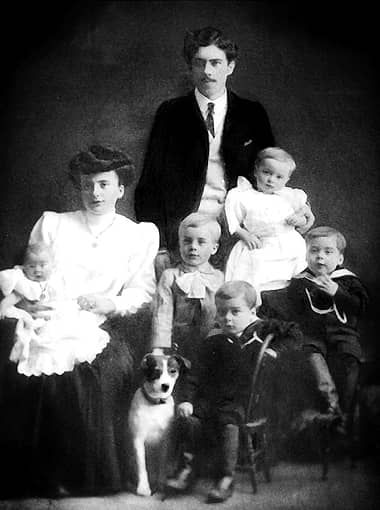
Westmore Family. From Left to Right: Wally held by Ada, George (standing), Monte (standing), Dorothy, and the twins, Ern (seated) and Perc.
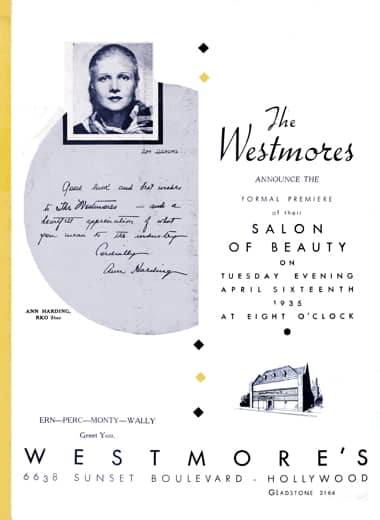
1935 Westmore Salon of Beauty.
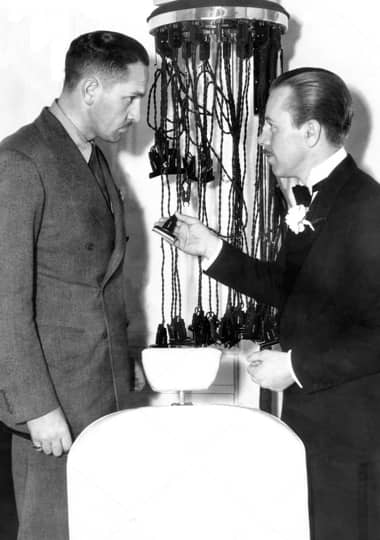
1935 Monte Westmore shows a permanent waving machine to Frederic March [1897-1975] during the opening of the Westmore Salon of Beauty.
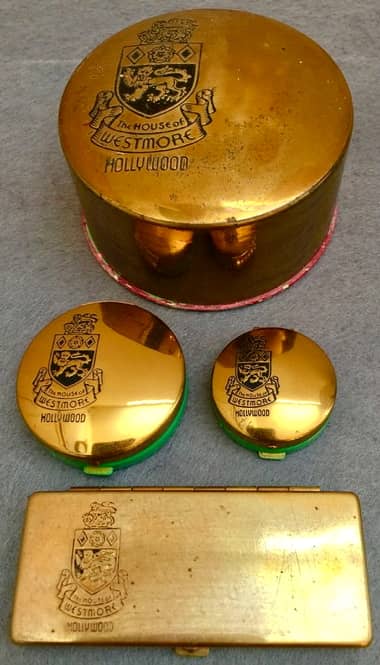
House of Westmore Face Powder and Compacts from the first line of cosmetics packaged in gold tones with a coat of arms to make them appear more luxurious.
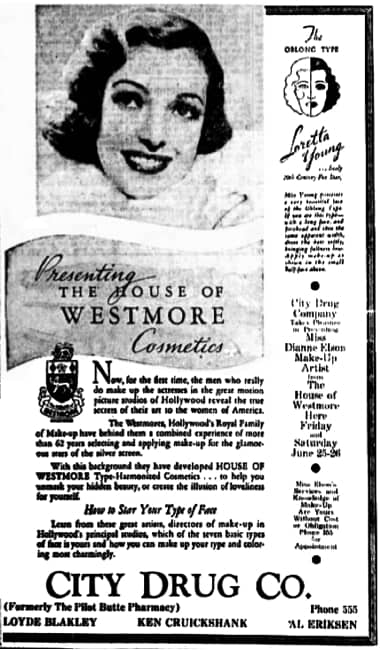
1937 House of Westmore Type-Harmonized Cosmetics.
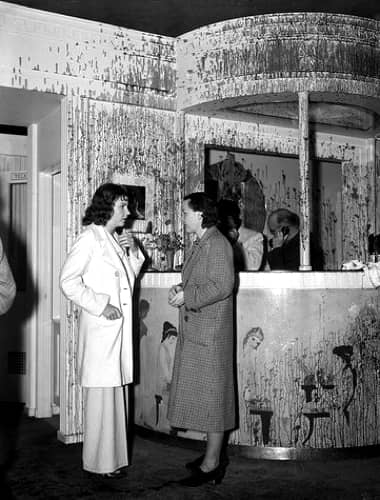
1937 Damage done to the House of Westmore Salon of Beauty on May 3 during the Federated Motion Picture Crafts strike. Repair costs were estimated to be over US$10,000 and the salon was closed for weeks with a further loss in revenue.
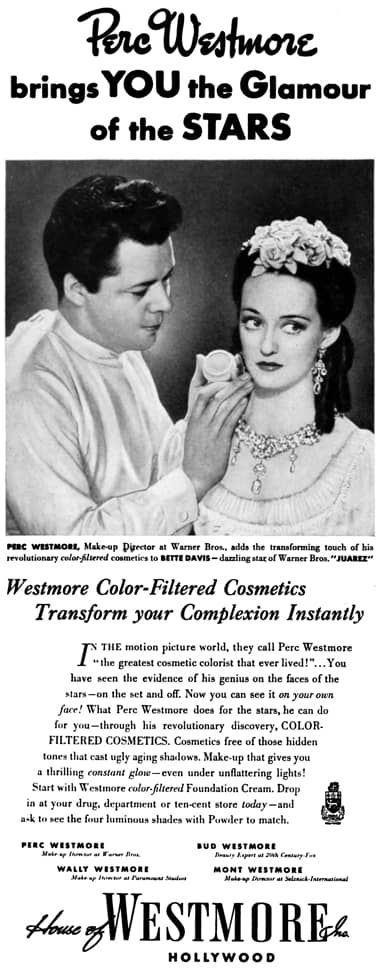
1938 Westmore Color-Filtered Cosmetics.
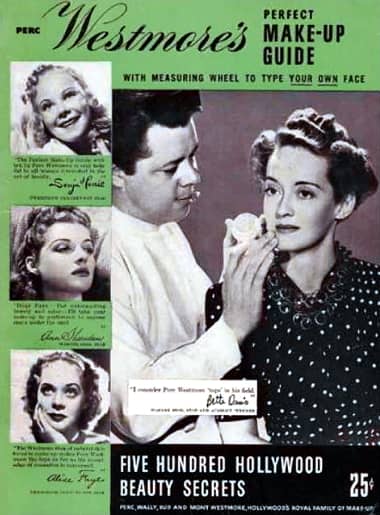
1939 Perc Westmore’s Perfect Make-up Guide.
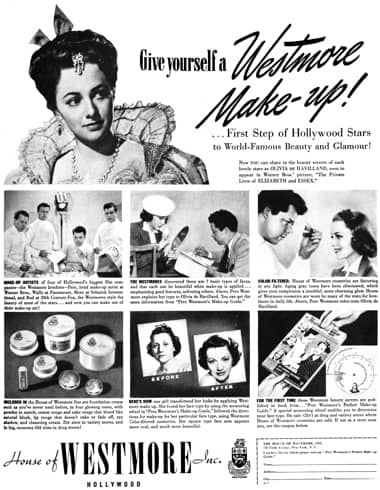
1939 Westmore Make-up.
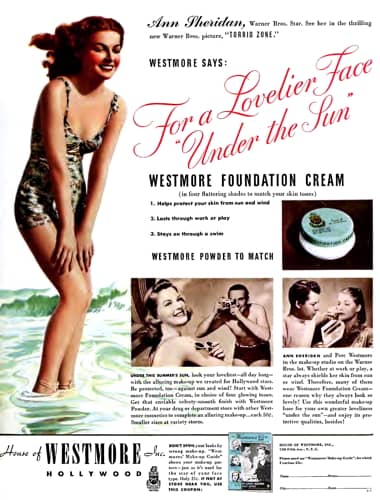
1940 Westmore Foundation Cream.
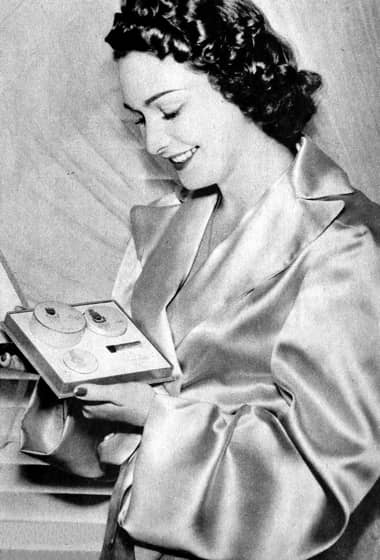
1940 Westmore Make-up Kit, foundation powder, rouge and lipstick.
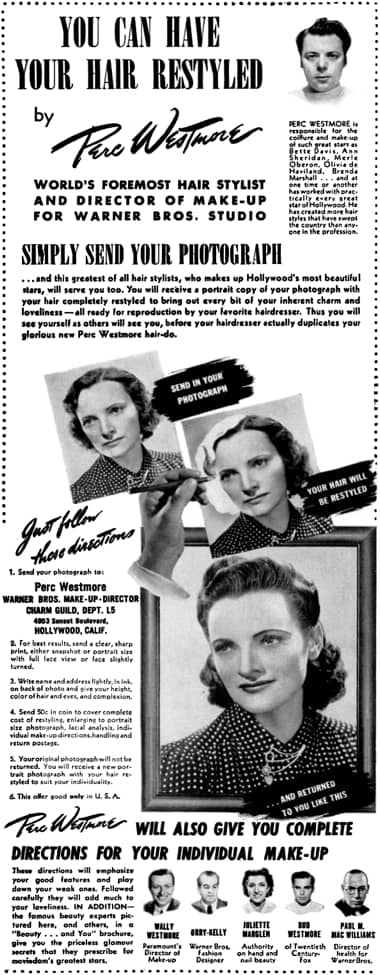
1941 The Westmore brothers pursued other opportunities to monetise their fame. Here Perc, Wally and Bud Westmore combine forces with Orry-Kelly (Warner Bothers’ fashion designer), Juliette Marglen (hand and nail authority) and Paul MacWilliams (director of health at Warner Brothers) in a mail-order makeover promotion. Juliette Marglen ran the manicure salon at the Westmore House of Beauty for many years before establishing her own cosmetic line.
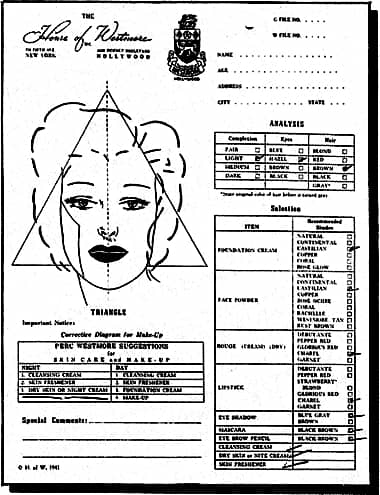
1942 Westmore chart used in a Westmore in-store promotion. This chart is marked for a woman with a triangle face with a light complexion. hazel eyes and brown hair. The assistant has suggested the Castillan shade of Foundation Cream and Face Powder, Charel Rouge and Lipstick, and Blue Gray Eyeshadow.
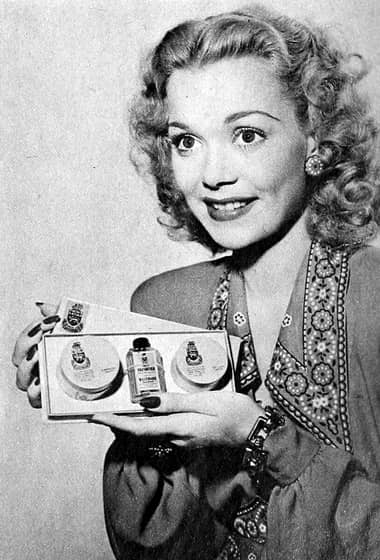
1942 Westmore Hollywood Pickup Kit: Cleansing Cream, Freshener, and Dry Skin Cream.
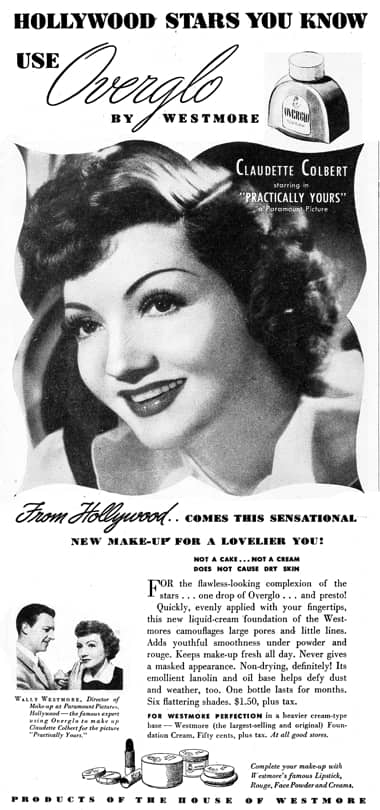
1944 Westmore Overglo Liquid Cream Foundation packaged in a bottle designed by the industrial designer Raymond Loewy [1893-1986]. To use Overglo, you shook the bottle well, removed the cap, and turned it upside down upon a forefinger. The amount left on the finger was said to be all that was needed to cover the face.
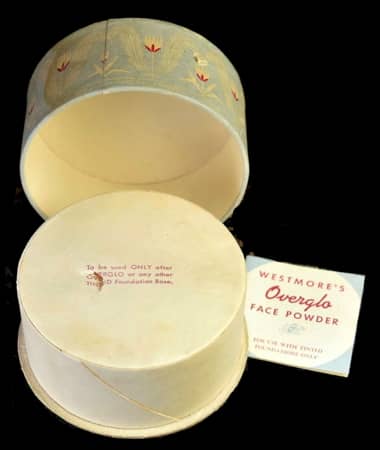
Westmore Overglo Face Powder.
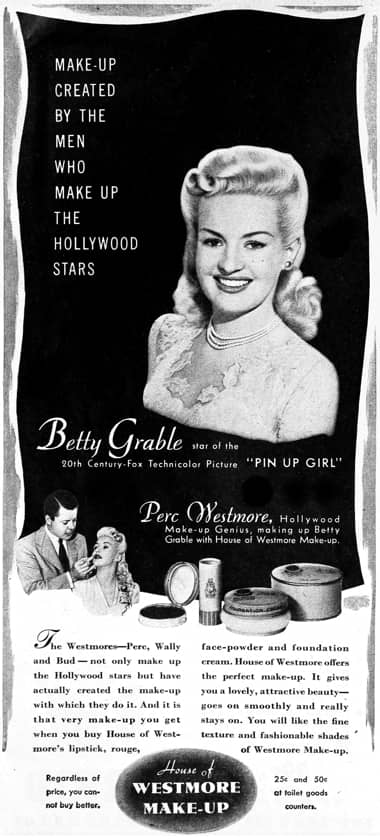
1944 House of Westmore Make-up.
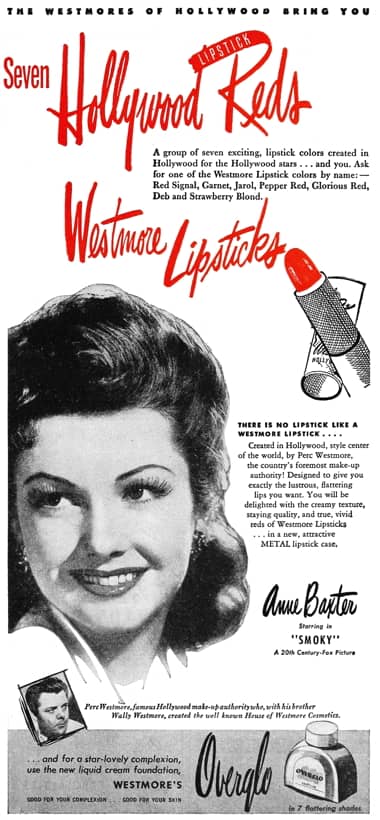
1946 Westmore Hollywood Reds. Shades: Red Signal, Garnet, Jarol, Pepper Red, Glorious Red, Deb and Strawberry Blonde.
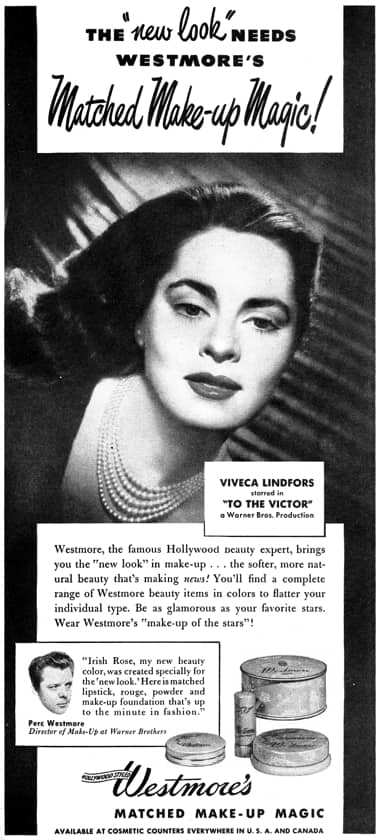
1948 Westmore Matched Make-up. Unfortunately its ‘Matched Make-up’ promotions were missing a vital component, nail polish. So, although Westmores added new lipstick shades through the 1950s these were treated more like staples and not the fashion items introduced every spring and fall from companies like Revlon.
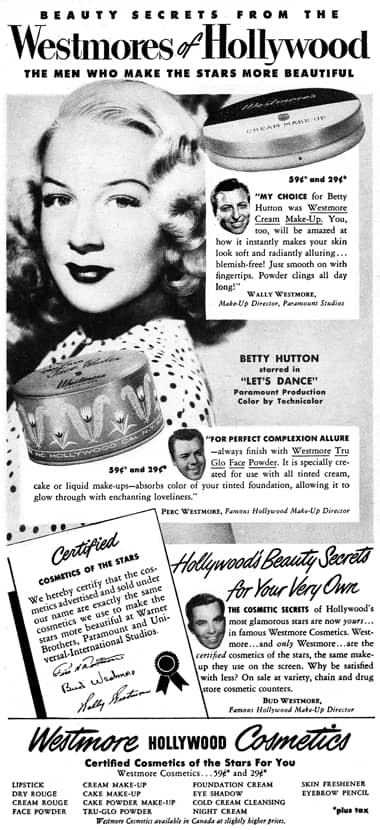
1950 Westmore Tru-Glo Face Powder.
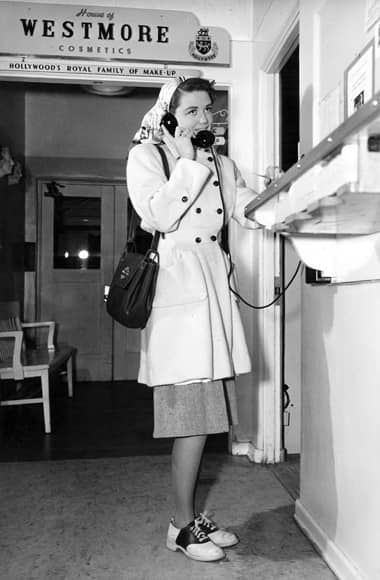
Dorothy Malone [1924-2018] at Westmores.
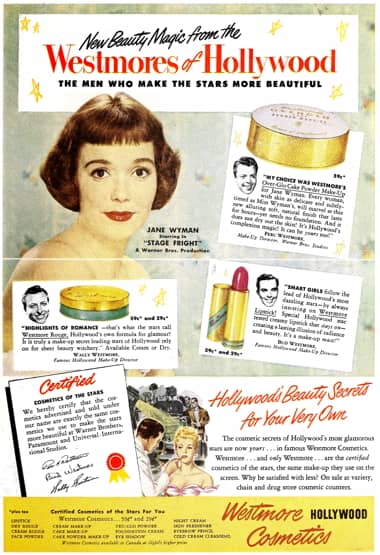
1950 Westmore Overglo Cake Powder Make-up, Rouge and Lipstick in the last year that Perc Westmore was the make-up director at Warner Brothers
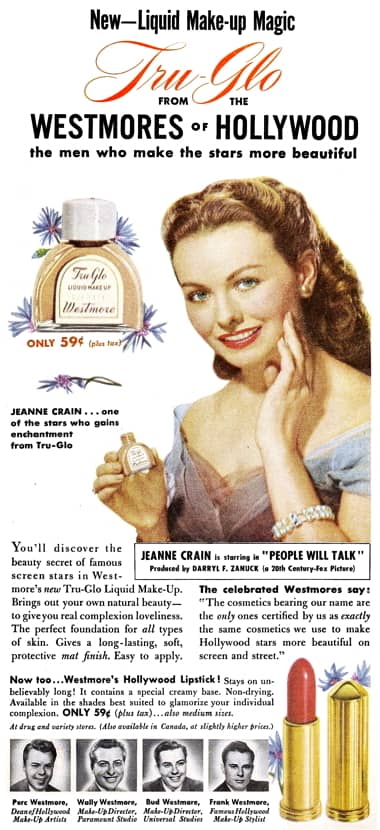
1951 Westmore Tru-Glo Liquid Make-up and Hollywood Lipstick. Frank has joined Perc, Wally and Bud Westmore.
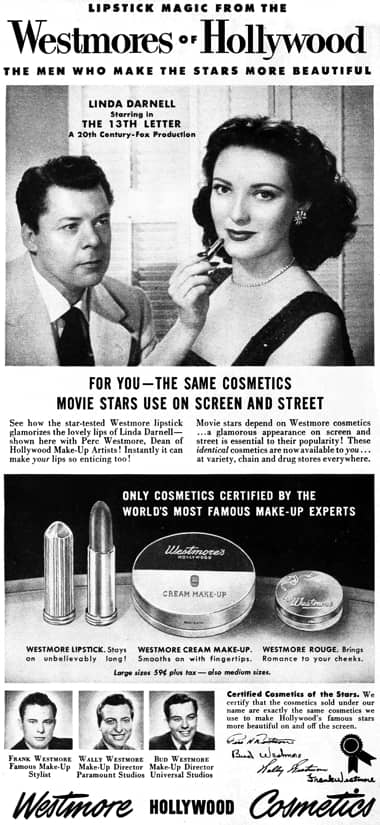
1951 Westmores of Hollywood. Having resigned from Warner Brothers in 1950, Perc is now referred to as the ‘Dean of Hollywood Make-up Artists’.
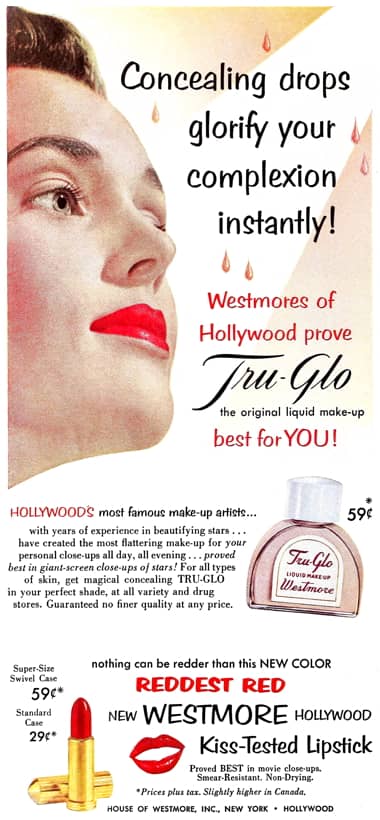
1955 Westmore Tru-Glo and Kissed-Tested Lipsticks.
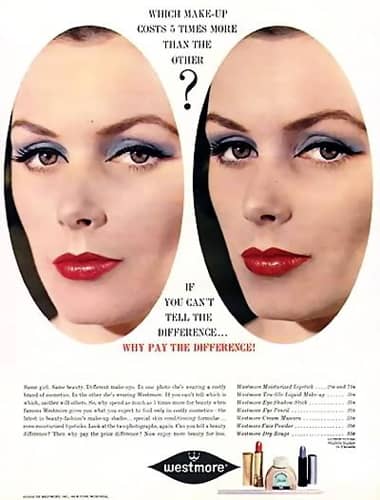
1961 Westmore cosmetics. The company was now competing largely on price.
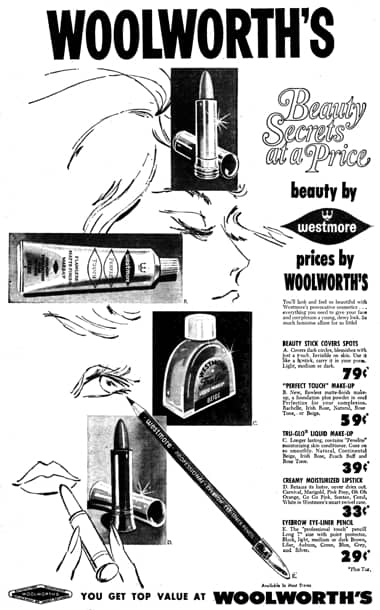
1963 Westmore Beauty Stick, Perfect Touch Make-up, Tru-Glo Liquid Make-up, Creamy Moisturized Lipstick and Eyebrow Eyeliner Pencil.

1964 Westmore Lip and Nail Colors.
